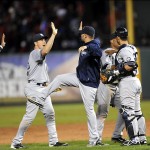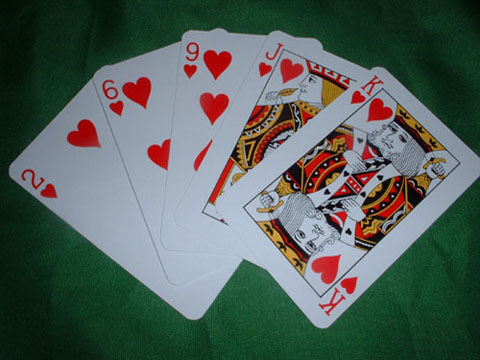As part of our free games blog, we at Spoiled Flush Games have decided to give readers a peak at the actual game-design process that led to each game. We hope that somebody out there will find these things useful — or at least mildly interesting.
As we’ve mentioned before, these free games are the result of a long-running game design project. The goal was to design 52 card and dice games that could be played with a standard deck of cards, and/or hobby dice, and/or common items you probably have in your house. These restrictions bred a good deal of creativity. We learned to think of gaming components in new and interesting ways, pulling the maximum gameplay value out of each piece. Some of the games started off with a specific aim in mind, others just with a single mechanic or idea. In the end, we did manage to design all 52 games. Though we never published the book, we’re happy be able to finally share these games with you, along with some insights on how they came to be!
The first game in the series is Playing Card Baseball.
This was a strictly top-down design. Our goal here was to create a quick, fun baseball game that captured the feel of the national pastime. We were living in Boston at the time, and it was 2004. Anyone who follows baseball even remotely knows that 2004 was a special year for Boston sports — it was the year the Red Sox finally won the World Series, breaking the infamous curse, and the city was in the grips of baseball fever. We actually designed the game while watching game one of the ALCS. Red Sox fans will remember that as a pretty brutal game — the Yankees won 10-7, but it wasn’t really that close — so it was nice to have a distraction.

Our blood still boils after all these years
Creating a baseball game seemed natural, but we didn’t want to repeat the mistakes of past baseball card and board games. Instead of bogging the game down with stats, specific rules for batting, pitching, catching, fielding, errors and the like, we decided to go the opposite direction and boil the game down to a super-simple abstraction.
Often when we design a game, we ask ourselves “What is the central tension of the game?” When you look at Baseball, the sport, the central conflict is the showdown between the pitcher and the batter. Everything else is execution of fundamentals (base running, fielding, personnel decisions…) That stuff is interesting for a dedicated fan, but when you’re looking for the drama, it all comes down to the pitcher vs. the batter.
What we needed was a simple, robust batting resolution mechanic. The inspiration for it came from a pretty unlikely source: a game that Sam played in elementary school music class, called Music Baseball.
In Music Baseball, the class was divided into two teams, and those teams were put in a sort of “batting order.” The teacher would play a short tune on the xylophone, and the kid at bat would have to sing the tune back. The longer — and therefore more difficult — the tune, the more bases the kid could take. A three-note tune was a single, a four-note tune was a double, and so on.
It was so simple, but it preserved much of the tension of an at-bat. You step up. Everything’s on the line. You aim for the stands and take your swing, and either achieve success (a hit!), or get out.
Kevin, meanwhile, noted that one of the most beautiful things about baseball is that the batter has to work with what the pitcher gives him. The pitcher, meanwhile, has to deliver the very instrument of his potential downfall to the batter, but in so doing controls the game.

Work with THIS!
Based on those ideas, the basic system came together quickly. The pitcher would start with more cards and throw a symmetrical pitch, determining a number of cards for both players to draw. The batter would then decide how ambitious he wanted to be, just like in Music Baseball.
That was all cool, but we still needed a way to decide who had won the at-bat. Those with a good memory of ’04 will also remember it as the height of the Texas Hold ‘Em Poker craze that swept America. We were avid players, and had poker on the brain almost constantly. Like baseball, the drama of poker comes down to a series of big showdowns. It’s also a simple, quick method of resolving victory, and one that most people are already familiar with.
We patched the two systems together, and the end result is a quick, simple pitching and batting system that’s high on drama, and manages to capture the feel of baseball quite nicely. Though the batter and pitcher will always wind up with the same number of cards if the batter goes for a single, the pitcher’s ability to dictate the flow of the game gives him a distinct advantage, so much so that the game produces an on-base-percentage shockingly similar to actual baseball.

What a fast ball down the center might look like. When you draw nine or more cards, flushes and straits become much more common.
From there, it was easy to add on little extras — simple rules for stealing, double plays, pinch hitters and the like, that add a touch more strategy to the game for baseball purists or gamers who seek out meaningful decisions in every game (we happen to fall into both of those categories). To this day, we still play baseball when we’ve got time to kill, and it hasn’t gotten old after eight years.
If any lessons can be pulled from this story, I think these are they:
- When building a top-down design, look for the central tension in whatever you’re trying to evoke, and concentrate on this. Everything else should serve that tension. Don’t get too bogged down in simulating every little thing.
- Inspiration for a great mechanic can come from anywhere. If you design games, play a lot of them, and think critically about how their mechanics serve the players.
- Strive for simplicity. We play Baseball more than any of our other Game Book games precisely because the rules are so darn simple and easy to remember.
We did eventually give in to our inner geeks and create an advanced version of Baseball, which includes rules for creating your team, as well as new special pitches, but that’s another post.
